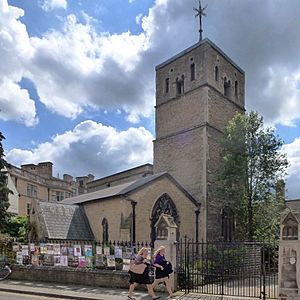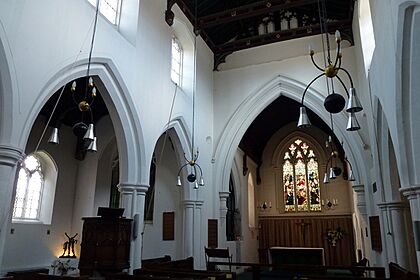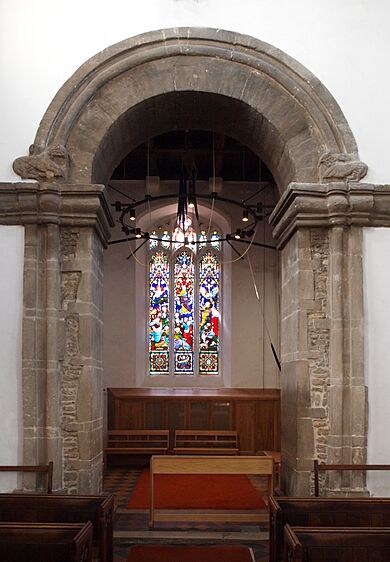St Bene't's Church facts for kids
Quick facts for kids St Bene't's Church, Cambridge |
|
|---|---|

St Bene't's Church with its Anglo-Saxon tower
|
|
| 52°12′13.0″N 0°07′06.0″E / 52.203611°N 0.118333°E | |
| Location | Bene't Street , Cambridge |
| Country | England |
| Denomination | Church of England |
| Website | https://www.stbenetschurch.org |
| History | |
| Status | Active |
| Founded | c.1020 |
| Architecture | |
| Functional status | Parish church |
| Heritage designation | Grade I listed |
| Specifications | |
| Tower height | 70ft |
| Bells | 6 |
| Tenor bell weight | 13-3-3 in F# (700kg) |
| Administration | |
| Archdeaconry | Archdeaconry of Cambridge |
| Diocese | Diocese of Ely |
St Bene't's Church is a very old Church of England parish church located in the heart of Cambridge, England. It is famous because parts of it, especially its tower, were built by the Anglo-Saxons. This makes it the oldest church in Cambridgeshire and the oldest building in Cambridge!
The church is named after Saint Benedict of Nursia. He was the founder of a group of monks called the Benedictine order. The name "Bene't" is a mix of an old English name and the Latin name for Benedict. People have called it different names over the centuries, but today it's usually "St Benet" or "St Bene't".
Contents
Finding St Bene't's Church
The church is on the south side of Bene't Street. It sits right next to Corpus Christi College. For a long time, until 1579, St Bene't's was actually the college's own chapel. Even today, the college still helps support the church. Across the street from the church, you can find the famous Eagle Pub.
A Look Back in Time: Church History
The Ancient Anglo-Saxon Tower
The most amazing part of St Bene't's is its Anglo-Saxon tower. Experts believe it was built a very long time ago, between the years 1000 and 1050 AD. The tower has special corner stones called "long-and-short quoins." These stones stick out, showing that the tower was once covered in a smooth plaster-like material. Inside the church, the arch that supports the tower is also from the 11th century and is a key feature.
Changes Over the Centuries
Around the year 1300, the main part of the church, called the nave, was rebuilt. The side sections, known as aisles, were also updated. Later, in the 1800s, during what are called Victorian restorations, the church was made wider. In 1853, a new north aisle was built. Then, in 1872, the south aisle and other parts were rebuilt. During these works, builders found old Anglo-Saxon foundations. These showed that the original church was wider than it is now.
The front part of the church, the chancel, was changed in the 1200s. You can still see some of the old, tall, narrow windows from that time. Some special seats and a basin for washing hands, called a sedilia and piscina, were added in the 1300s. The roof of the main part of the church was added in 1452.
The church is considered a very important historical building. It is a Grade I listed building. This means it has special protection because of its history and architecture.
The Church Bells
For many years, from its earliest days until the 1600s, the University of Cambridge actually paid St Bene't's Church to use its bells! A record from 1273 shows that the church agreed to let the university ring the bells if they paid a "customary gratification." This payment was about six shillings and eight pence each year. The university kept paying this until 1624.
The Six Bells of St Bene't's
The tower at St Bene't's has a set of six bells that can be rung together in a special way called Change ringing. Five of these bells are very old, from the 1500s or 1600s.
- The second bell is the oldest, made in 1588.
- The third bell was made in 1607 by Richard Holdfield from Cambridge.
- The fifth bell was also made by Richard Holdfield in 1610.
- The largest bell, called the tenor bell, was made in 1618.
- The smallest bell, the treble bell, was made in 1663.
- The newest bell is the fourth one, made in 1825.
It's quite rare to find bells made by some of these old bell founders today!
Important People Connected to St Bene't's
Many interesting people have been part of St Bene't's Church over the years.
- Michael Ramsey, who later became the leader of the Church of England as Archbishop of Canterbury, was the vicar (a type of priest) here from 1938 to 1940.
- From 1945 to 2005, a group of monks called the Brothers of the Society of Saint Francis served at the church.
- The Revd Canon Angela Tilby, who often speaks on BBC Radio 4, was the vicar from 2007 to 2011.
- The Revd Canon Anna Matthews was the vicar from September 2012 until she passed away in March 2023.
- Revd Dr James Gardom took over the role from 2023 to 2024.
- The Revd Devin McLachlan became the new Vicar on September 13, 2024.
Fabian Stedman (1640–1713), who helped create the special way of ringing bells called change ringing, was also a clerk at this church in the mid-1600s.
More to Explore in Cambridge
If you like old buildings, you might also be interested in these places in Cambridge:
- Leper Chapel of St Mary Magdalene: This chapel dates back to 1125.
- Church of the Holy Sepulchre, Cambridge or Round Church: This church was built around 1130.
- School of Pythagoras: This is the oldest non-religious building in Cambridge, from about 1200.
Images for kids





